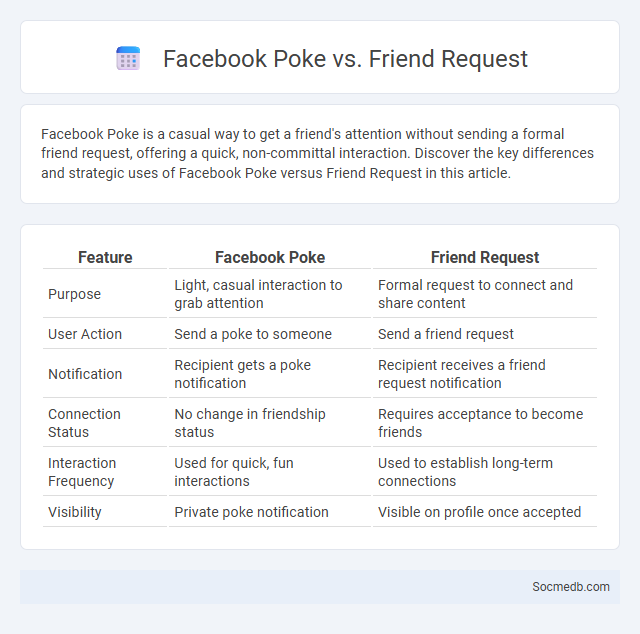
Photo illustration: Facebook Poke vs Friend Request
Facebook Poke is a casual way to get a friend's attention without sending a formal friend request, offering a quick, non-committal interaction. Discover the key differences and strategic uses of Facebook Poke versus Friend Request in this article.
Table of Comparison
| Feature | Facebook Poke | Friend Request |
|---|---|---|
| Purpose | Light, casual interaction to grab attention | Formal request to connect and share content |
| User Action | Send a poke to someone | Send a friend request |
| Notification | Recipient gets a poke notification | Recipient receives a friend request notification |
| Connection Status | No change in friendship status | Requires acceptance to become friends |
| Interaction Frequency | Used for quick, fun interactions | Used to establish long-term connections |
| Visibility | Private poke notification | Visible on profile once accepted |
Introduction: Understanding Facebook Interactions
Facebook interactions are essential for building your online community and increasing engagement on your posts. Understanding likes, comments, shares, and reactions helps you tailor content that resonates with your audience and boosts visibility in the Facebook algorithm. Analyzing these interactions provides valuable insights into audience preferences and behavior, enhancing your social media strategy.
What Is a Facebook Poke?
A Facebook poke is a simple interaction tool that allows users to send a virtual "hello" or get someone's attention without sending a message. This feature is designed to initiate contact or re-engage with friends on the platform discreetly. You can use a poke to spark conversation or remind someone about your presence in a playful and casual way.
The Purpose and History of Facebook Poke
Facebook Poke was designed to allow users to send quick, temporary messages, photos, or videos that disappear after being viewed, emphasizing ephemeral communication. Launched in 2012, it aimed to capitalize on the growing trend of fleeting interactions popularized by apps like Snapchat. Your engagement with Facebook Poke provides insight into early attempts at creating spontaneous and privacy-focused social media experiences.
What Is a Facebook Friend Request?
A Facebook friend request is a connection invitation sent through the platform, allowing you to expand your social network by adding new contacts. When someone sends you a friend request, you have the option to accept or ignore it, controlling who can see your personal posts and profile information. Managing your Facebook friend requests effectively ensures your social interactions remain secure and tailored to your preferences.
The Role of Friend Requests in Social Connection
Friend requests serve as a fundamental gateway to expanding your social network on platforms like Facebook, Instagram, and LinkedIn, enabling new connections and interactions. These requests facilitate trust-building by allowing users to approve or decline potential friends, thus curating their digital social circle based on mutual interests or established relationships. Engaging with friend requests actively enhances social connectivity and promotes a sense of belonging within online communities.
Facebook Poke vs Friend Request: Key Differences
Facebook Poke allows users to send a brief, attention-grabbing notification without adding someone as a friend, serving as a lightweight form of interaction. In contrast, a Friend Request is a formal invitation to connect, enabling full access to a person's profile and updates upon acceptance. While Poke is transient and casual, Friend Requests establish lasting social connections within the Facebook network.
When to Use Poke vs Friend Request
Use a Friend Request to establish a formal connection on social media, signaling a desire to add someone to your network and gain full access to their profile. A Poke is a casual, lightweight interaction designed to grab attention or say hello without the commitment of becoming friends. When initiating relationships, Friend Requests are appropriate for genuine connections, while Pokes serve as informal, playful prompts.
Pros and Cons of Poking on Facebook
Poking on Facebook offers a simple way to grab someone's attention without sending a full message, making it a low-pressure interaction tool for users to initiate social engagement. Your poke can serve as a casual greeting or an icebreaker, fostering connections in a non-intrusive manner while allowing the recipient to respond at their convenience. However, frequent or unsolicited pokes may be perceived as annoying or intrusive, potentially leading to misunderstandings or negative impressions in your social network.
Privacy and Engagement: Managing Your Interactions
Social media platforms often collect extensive personal data, making privacy settings crucial for controlling what information is shared and with whom. You should regularly review and customize your privacy preferences to manage your interactions and safeguard your digital footprint. Engaging thoughtfully by limiting public posts and adjusting audience controls helps maintain both your privacy and meaningful connections online.
Conclusion: Choosing the Right Interaction on Facebook
Selecting the appropriate interaction on Facebook enhances user engagement and strengthens community connections. Tailoring responses through likes, comments, or shares aligns content with audience preferences and boosts visibility. Strategic interaction choices optimize social media impact and foster meaningful online relationships.
 socmedb.com
socmedb.com